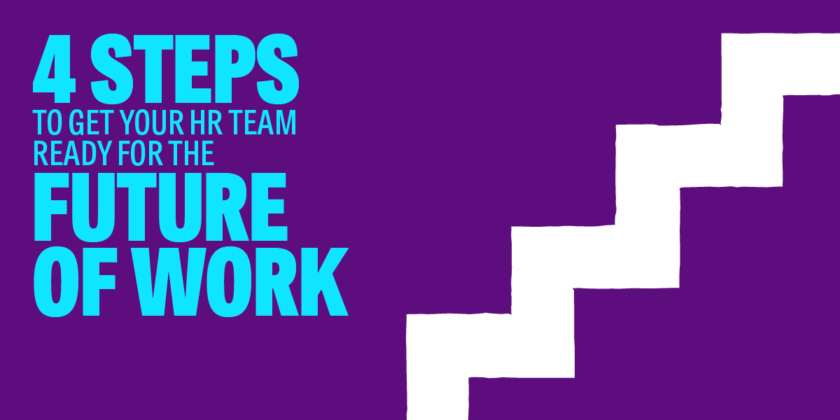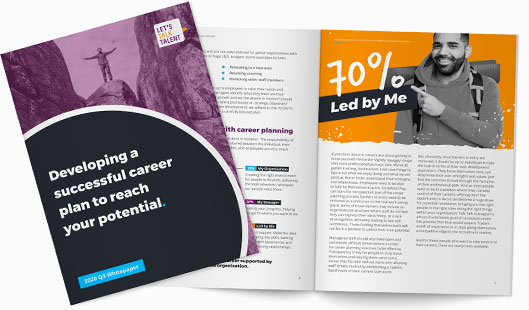The 4 steps to follow to get your HR team ready to take on its future role
It’s no secret that HR departments have come a long way since the days of Personnel. And we’ve gone through a fair few revolutions since then too; none bigger and more sudden than the new reality brought on by the pandemic. From helping offices everywhere transition to a virtual (and hybrid) model, to remotely laying off or onboarding employees and overall turning everything around with each newly-announced sanitary measure, it’s been a period of constant change. Now that the dust has settled, what does the future of work look like?
Whilst nobody could have predicted the last few months (or years), now is the perfect time to think ahead and plan how HR departments will be required to structure themselves in order to support the future needs of their organisations. And, more importantly, whether or not your people are ready to take on this next challenge.
At Let’s Talk Talent (LTT), we think businesses should take this opportunity to ask themselves whether they have the right people, with the right skills, in the right place, doing the right things to set their HR teams up for future success.
And what is the best way to give your people the experience and exposure they will require over the coming years? Career pathways of course! Designed to propel your employees’ careers forward as well as future-proof your business, career pathways ensure your people’s skills are closely aligned to your organisational needs, both current and future.
Here are four simple steps to design career pathways for your team members, and get your department ready for what’s to come over the next few years.
Using career pathways to unlock your HR team’s potential
“We’ve come a long way since Personnel was just the place you went to to get sacked,” says Jo, MD at LTT. “We then moved on to the kind of HR that was all about admin and paperwork. Now, we are blessed with professionals who are focused on putting employees at the core of everything they do, and creating the best Employee Experience (EE) possible,” she adds.
In short, the skills required of an HR professional today are very different to those required several years ago. Professionals are now bringing in all kinds of skills, expertise and knowledge, from data analysis to Diversity and Inclusion (D&I) and mental health support.
So, isn’t it time for a rebrand? Shouldn’t HR departments be thinking about the full range of tools and services they could offer employees, and ensure they have the right specialists in the right place to unlock their full potential?
“It’s time to evolve once again. Gone are the days of Human Resources. It’s time for People Experience,” states Jo. So how can HR functions everywhere take the next step and get their departments, and their people, ready to dive into the next phase of HR?
Here’s now.
Step 1: Define what the future of HR will look like for your organisation
The first step is a simple one: ask yourself what HR’s role will be over the next two years. How will you be required to support your organisation?
Start by reviewing your employee experience to determine which areas need focus, and therefore where your team could be needed the most. Make sure your Employer Value Proposition (EVP) reflects the reality of working with you and attracts the kind of talent your organisation will need to survive and thrive.
This is no different from defining your Customer Value Proposition (CVP). Internal customers are as crucial as external ones, and reviewing your employee experience with a customer lens can help you determine where your team could have the biggest impact over the next 24 months.
This will be your main objective, and ultimately help you align your plan of action to business priorities, as you aim to gain the kind of specialist skills and expertise that will help you reach your goal.
Step 2: Use data analysis as the starting point for career pathways
Use the data gathered by your various systems to create a narrative. What’s the lay of the land? Is data telling you that you may be losing talent to competitors? Do you know why? Are you struggling to retain new hires? Are your leaders burnt out or exhausted? Are you focussing on reward and recognition or are your people not feeling valued?
The information gathered may indicate that you need to create new roles (such as D&I or wellbeing specialists), gain new skills (such as learning to use a new software, for example), or deepen your expertise in a particular field.
Data is crucial when it comes to figuring out where you stand against your future objectives, and how far you have to go. But gathering data is only one variable in the equation. Learning to tell the story behind it is equally crucial, and will allow your organisation to be proactive and anticipate future trends, rather than just react to them.
Step 3: Map out the roles needed within your HR department
At Let’s Talk Talent, we have created a tool designed to help you map out future career roles (see an example of our Career Navigator here). So, once you’ve established what the next two years of HR will look like for your organisation, what your top priorities are, and where your team currently stands, use our Career Navigator to map out the roles required within your department to allow for your plan’s implementation.
The Navigator will help you by highlighting the various HR functions required within a team, depending on the level of expertise needed and your overall strategy. For example, is your main challenge talent and recruitment, and do you need to create a whole community of practice solely focused on this field? Should you review your reward and recognition programme to take into account the new cost of living reality and need to pull resources to work on this? Do you require data specialists that can gather and analyse information for your entire department?
This exercise will determine if your current structure is setting you up for future success, or if you need to implement some changes in order to achieve your goals.
Step 4: Create HR career pathways to prepare for the next few years
Now that you have a clear idea of where you stand, and what you will need in order to reach your goal, all that’s left to do is to create a concrete, actionable plan. This is where career pathways come in.
Designing, communicating, and implementing detailed pathways for each member of your HR department will ensure they know how they can propel themselves forward, unlock their full potential and acquire the kind of skills and knowledge that will be required for the future within your organisation.
To do this, use the STAR model, a powerful tool when it comes to identifying the Skills, Training, Attributes, and Relationships needed for staff to take their career to the next level.
You’ve probably done this step thousands of times before, for the people in the various teams that make up your organisation. HR is no different, and your team members should have a clear career progression plan that makes them feel valued and shows them how to contribute to wider organisational success.
We all know that lack of career development is the number one reason behind people leaving an organisation. Make sure you give your employees the right development opportunities based on both their personal goals and the organisation’s strategic needs for the future.
Conclusion
Creating career pathways in order for your team to gain new skills and knowledge is a must. But, ideally, HR departments should take a step further and ensure they focus these new skills on filling the roles your department will require over the next few years.
HR, just like any other department, should be prepared to face whatever is coming next and be ready to support their organisation and its future needs. And if the past is any indication of what’s to come, we can all expect some (potentially radical) changes over the next few years.
Make sure you have everything in hand that you’ll need to anticipate trends and determine who you have on your bench, and give yourself the tools you need to not only survive the next few years, but to thrive as a department.
Happy future planning!
If you’d like a bit of support to develop effective career pathways that will really hit the mark for your team members, don’t hesitate to book a meeting with us. We’d be happy to help. Or download our free Career Planning whitepaper as a starting point.

